Dell Venue 8 Pro review: a good Windows tablet, but wait for the bug fixes

And then there were... four? Once considered a novelty, 8-inch Windows tablets are now everywhere: Lenovo has one; so does Toshiba; and Acer is already on its second. Not to be left out, Dell recently started shipping the Venue 8 Pro, which costs about the same as its competitors ($300), but adds an active digitizer for pen input (psst: The stylus is sold separately). Like most of its rivals, too, it makes use of a quad-core Intel Atom processor promising fairly long battery life, and enough power to handle some lightweight desktop apps, in addition to whatever you might download from the Windows Store. Unfortunately, we can't really name our favorite 8-inch Windows tablet until we review a few more of them, but for now, we can safely say the Venue 8 Pro offers some decent value for the money. Read on to see why.
Hardware
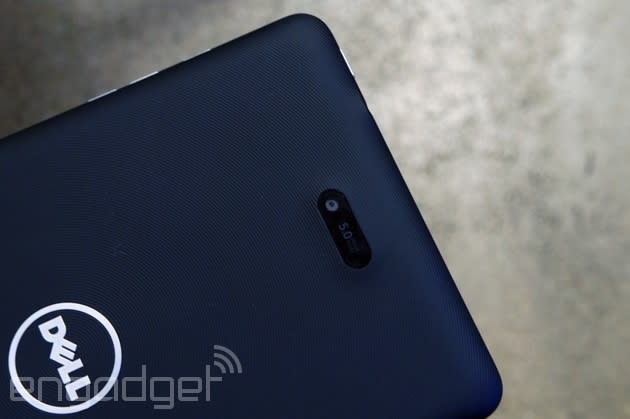
We know, we know: Looks aren't everything. But to the extent that good design and build quality matter (especially on budget devices like these), Dell is off to a fine start. Unlike its rivals, which mostly have plain plastic backs, the Venue 8 Pro is coated in a soft, rubbery finish (available in black and red) that makes the device easier to grip and also lends it a premium feel -- not unlike how we felt about the rubber back on the original Nexus 7. Be warned, though, that while the textured back cover does a good job masking fingerprints, it is susceptible to scratches. Granted, you probably won't ding it up just by putting it in a bag with other items, but at one point, I accidentally scraped it with the micro-USB cable while attempting to plug in the device. It's a faint mark, but still, I can't unsee it. At least the glass on the front side seems pretty scratch-resistant.
You'll be hard-pressed to find an 8-inch tablet that isn't thin, light and easy to hold in one hand. Nonetheless, all that's true of the Venue 8 Pro: It immediately makes a good case for choosing an 8-inch tablet over a 10- or 11-inch one. According to our own Sean Buckley, who owns one, it's even small enough to fit in the back pocket of his (not-too-skinny) jeans. As it happens, though, it's even more compact than some rival models. All told, the tablet weighs in at 0.87 pound and measures 0.35 inch thick, leaving just enough room on the edges for you to comfortably rest your fingers. The Acer Iconia W4, meanwhile, weighs 0.91 pound and measures 0.42 inch thick; Toshiba's Encore tablet also nears the one-pound mark, landing at 0.98 pounds. Point being: You can't do much better than the Venue 8 Pro, at least as far as portability goes.
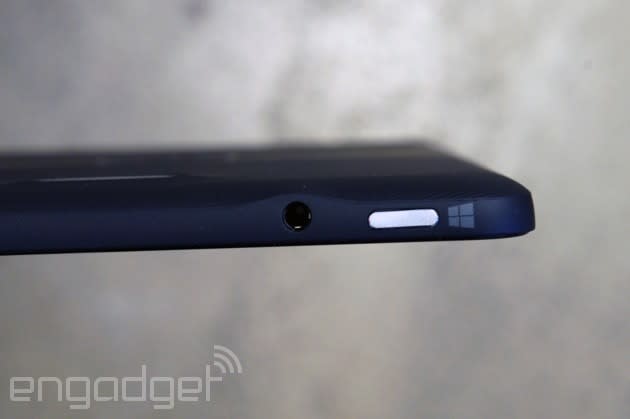
One thing that makes the Venue 8 Pro a bit strange to use at first: It appears to be missing a Start button. More precisely, it has one; it's just not where you'd expect it to be. Instead of a touch-sensitive Start button built into one of the bezels, the tablet has a physical Start key located on the top portrait edge of the device. We'll be honest, it took us a little while to stop tapping the bezels and go straight for the physical button. That said, now that we've gotten the hang of it, we have to give Dell credit for at least choosing the button location carefully. Since the key sits on the top edge, over toward the right, it's easy to hit when you're using the tablet in portrait mode, and also when you flip it over into landscape, at which point the button is within reach of your left thumb. Still, a capacitive key would've been even easier. Will you do that for us next time, Dell? At least consider it?
Continuing our tour of the hardware, you'll find most of the usual suspects: a headphone jack up top, with a micro-USB charging port, power/lock button and volume rocker on the right portrait side. There, you'll also find a covered microSD slot to augment the 32GB or 64GB of built-in storage. And yes, you probably will want to insert a memory card -- after installing a bunch of games and 10 gigabytes of comics, we burned through 64GB alarmingly quickly. One thing you won't find: a micro-HDMI port. That's a shame if you ever feel like pushing your HD content to a bigger screen (N.B.: This does support the Miracast wireless streaming standard, but it's not fair to expect that everyone's TV will be compatible). Meanwhile, other 8-inch tablets like the Toshiba Encore do offer this, so if mirroring your apps on a big screen is a priority, you at least know where to look.

The left side of the tablet is blank, and on the bottom, you'll find the lone speaker. That means if you're cradling the tablet in portrait mode while listening to music, the speaker grille will stand free and clear of your hands. But if you're holding it in landscape, there's a good chance your right hand will cover it. No matter, though: This speaker is gloriously, shockingly loud -- far louder than we'd expect a single speaker on a mobile device to be. Be warned, however, that the sound quality gets distorted at top volume, and the difference is especially stark if you're used to stereo sound on devices like the HTC One. At any rate, if you're listening to '80s hair metal, you'll want to take it down a notch to really appreciate the song.
Finishing up, there's a 5-megapixel camera around back, along with some "Intel Inside" branding and the usual FCC label, which can be a bit difficult to peel off. The 1.2MP webcam, meanwhile, is located on the front bezel, over toward the right corner.
Etc.
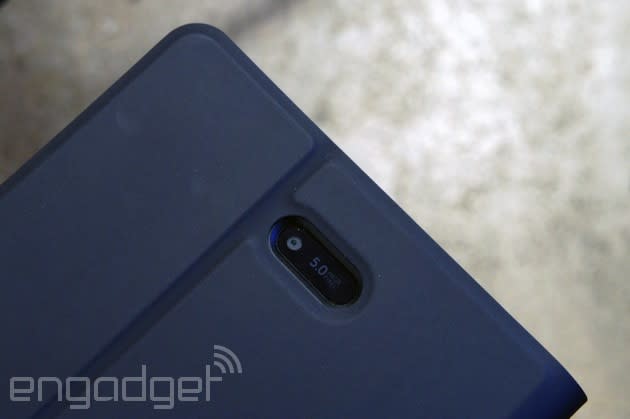
For $300, Dell is selling the Venue 8 Pro as a standalone slate, but we also thought we'd walk you through the accessories too -- you know, just in case you want to sometimes use the device as a pint-size laptop replacement. For starters, there's the $40 folio case, which has a tough shell and a soft suede-like lining. You can use it as a straight-up case, of course, but you can also fold it up, allowing you to watch movies with the screen propped up. There's also a second position, with the tablet lying face-up at a slight angle, making on-screen typing just a bit easier.
In our experience, we found the tablet stays put once you prop it all the way up, though it can be quite difficult to pry out of the case when you feel like going commando. (On the plus side, this means you don't have to worry about it falling out.) And what if you want to do some typing? Well, Dell has also announced a wireless keyboard, but it's not shipping yet and indeed, we haven't had a chance to try it.
Update: A day after this review posted, Dell began shipping the tablet with the keyboard and case, priced at $390 for the bundle.
Display
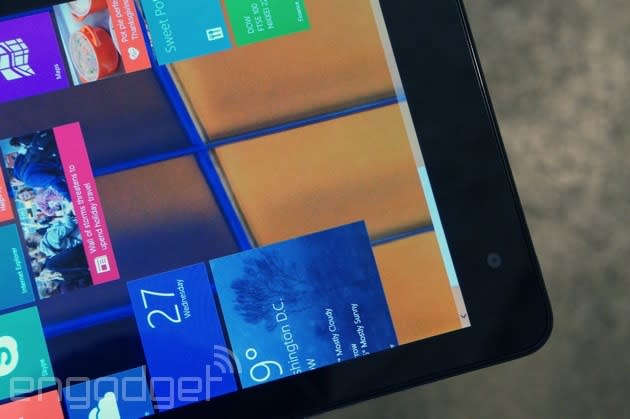
Given that the same Bay Trail processor powers all these 8-inch Windows tablets, there aren't many opportunities for companies to differentiate themselves: It's design, display quality and maybe camera performance. And... that's it. Fortunately, Dell didn't skimp on the screen -- the 1,280 x 800 IPS panel here is just lovely. The problem is, though the screen is rated at 400 nits, you'll rarely see the screen get that bright, at least not with auto-brightness turned on; for whatever reason, the tablet defaults to a very dim setting, and even if you manually adjust the brightness slider, you still can't go any brighter.
Fortunately, Dell says it's working on a firmware fix so that when you do use the ambient light sensor, the screen won't default to such a conservative setting. For now, unless you happen to be working in a dimly lit room, you'll want to turn off the ambient light sensor, even if it means a dip in battery life. Plus, even with the brightness at a more medium setting, colors are punchy, without being too saturated, and the screen is easy to view from various angles. So it is quite possible to enjoy the vibrant screen while still getting long battery life.
Dell surprised all of us when it announced the Venue 8 Pro with an active digitizer. Most 8-inch Windows tablets (heck, most budget tablets) don't support pen input. Here, though, you get a Synaptics digitizer built in, even on the base $300 model. It's a shame, then, that it doesn't work nearly as well as the pen displays you'll find on the Surface Pro 2 or any of the Galaxy Note tablets. In desktop mode, we were initially tickled by the pen's hovering capabilities, but our enthusiasm waned quickly after that. Sometimes, we had to try multiple attempts to launch a desktop program by double-tapping the shortcut with the pen. Other times, when using Explorer, the pen didn't initially highlight the object we wanted it to, or we would see stuttering as we tried to scroll through a long file list. So far, Dell has already issued at least one firmware update meant to address this problem, and it's also promising another fix that should hopefully make pen input even smoother.
Update: Dell recently issued an update to correct that pesky ambient light sensor issue. In short, the screen now defaults to a setting that makes the screen easier to read.
Software
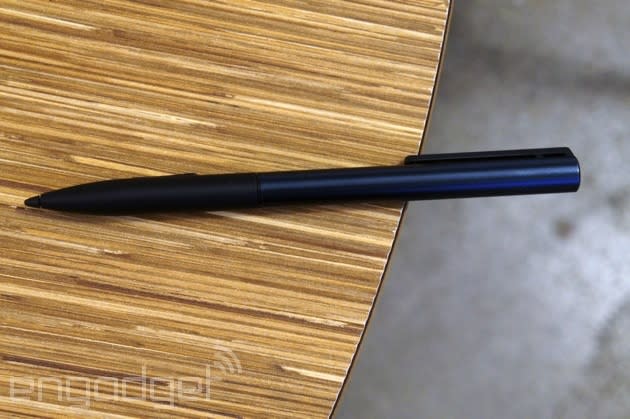
In retrospect, it's not surprising that Microsoft decided to showcase Windows 8.1 on 8-inch tablets: Many of the improvements to the OS make it especially easy to use on smaller-screened devices. For example, new keyboard shortcuts allow you to swipe the space bar to cycle through spelling suggestions, and to swipe various letters to expose the punctuation symbols that would otherwise be hidden. Also, you get more options for Live Tile sizes, including an extra small one that seems especially well-suited to smaller displays like this.
Additionally, all of the other headline features in Windows 8.1 can be found here, including an always-visible Start button in the lower-left corner of the desktop, expanded split-screen options and the ability to take photos from the lock screen (an especially handy feature on a smaller device like this). Also, as you've no doubt heard by now, Windows 8.1 ushers in a slew of new first-party apps, including Reading List (an alternative to Pocket), Bing Food & Drink, Bing Health & Fitness, a calculator, an alarms app and a sound recorder. Meanwhile, other built-in programs have received meaningful updates, with Xbox Radio and a new set of photo-editing tools, to name just two examples.
And what of third-party apps? We're happy to report the selection is steadily growing, even if there are still some holes. Flipboard recently arrived on the Windows Store recently, as has SlingPlayer, which launched as we were writing this review. Even before that, we had apps like Facebook, Twitter, Foursquare, Pandora, Rhapsody, Slacker Radio, Amazon Kindle, Nook, Zinio, Angry Birds, Bejeweled, Fitbit, Mint.com, NYTimes, Wall Street Journal, Hulu Plus, Netflix, ESPN, ABC Family, ABC News, NBC News, CBS, CBS Sports, CNN, MTV and the AP.
At this point, the ol' "Windows doesn't have enough apps" argument simply doesn't carry as much weight: The Windows Store catalog is growing, and it's growing fast. That said, if you buy the Venue 8 Pro (or any other Windows tablet), you still won't find every program you're searching for, at least not on the day you buy it. Some notable omissions? Instagram, Tumblr, HBO Go, Pocket and a first-party NPR player, to name just a few. Some major airline apps would be nice, too. Again, though, given how many heavy-hitters eventually made their way onto the platform, we have faith that most of these holdouts will join the fold at some point or another.
Performance and battery life
Device | PCMark7 | 3DMark06 | 3DMark11 | ATTO (top disk speeds) |
|---|---|---|---|---|
ASUS Transformer Book T100 (1.33GHz Intel Atom Z3740, Intel HD graphics) | 2,461 | 2,113 | E338 / P209 | 123 MB/s (reads); 58 MB/s (writes) |
Dell Venue 8 Pro (1.33GHz Intel Atom Z3740D, Intel HD graphics) | 2,343 | 1,986 | E299 / P164 | 86 MB/s (reads); 45 MB/s (writes) |
As we already discovered when we reviewed the ASUS Transformer Book T100, Intel's new Bay Trail processors are powerful enough to handle not just Windows Store apps, but also lightweight desktop programs like iTunes, Spotify and HipChat. That's true here as well: The Venue 8 Pro is fit to run all the above programs, along with Microsoft Office and even some games, as we'll describe in a moment. On the Metro Modern UI side, the Venue 8 Pro flies through animations and transitions, and opens apps quickly. It's worth noting that the processor used here, the Atom Z3740D, has a slightly lower clock speed than the Z3470 used in other tablets (1.83GHz max vs. 1.86GHz), along with less RAM support (up to 2GB, rather than 4GB). That said, you might not notice the difference, aside from benchmark scores.
Like the T100, it takes 11 seconds to boot up -- about half the time it takes the Surface 2 to fully load. Even more than that, though, the Venue 8 Pro's biggest talent might actually be web browsing: Pages load quickly and jumping between tabs is a breeze. If benchmarks mean anything to you, it notched a score of 405ms in the SunSpider JavaScript test. Remember, too, that lower numbers are better, so this actually surpasses the T100 (461ms) and falls right in line with the Surface 2 (406ms). Unfortunately, the Samsung-made SSD can't lay claim to such speed: It fails to break write speeds of 100 MB/s and its read speeds of 45 MB/s are even lower than what we achieved on the T100.
As for gaming, the Dell Venue 8 Pro's touch-only interface doesn't lend itself well to traditional titles, but its Bay Trail processor can run more than Windows 8 apps. Even so, don't expect it to replace your gaming rig: With few exceptions, the Venue 8 Pro stuttered heavily in most 3D-rendered games. Battlefield 3 and BioShock Infinite never stood a chance of being playable, but older games flourish. Games like The Elder Scrolls III: Morrowind ran without a hitch, and even Half-Life 2 chugged along at a steady 40 fps with low/medium details. Newer games can be coaxed into running, but they won't be usable: Skyrim, for instance, struggled to maintain 15 fps. Stick to older PC games (or the Windows 8 Store) and you'll be fine. Oh, and heads-up: During gaming and other intensive tasks, the tablet gets warm enough that you can feel the heat even through the folio case. If you're just surfing the web, though, you can expect the tablet to stay cool.
It's also worth noting that Civilization is playable as a purely touch-based game, as it's one of the only modern PC games that has a control mode designed specifically for tablets. It does stutter a little, but it works well enough to play, and even that's notable. After all, with the exception of Civilization, you won't get past simply "running" many games without peripherals to actually play them.
Tablet | Battery Life |
|---|---|
Dell Venue 8 Pro | 7:19 |
Microsoft Surface 2 | 14:22 |
Apple iPad Air (LTE) | 13:45 |
Nokia Lumia 2520 | 13:28 (tablet only) / 16:19 (with dock) |
Apple iPad mini | 12:43 (WiFi) |
Apple iPad mini with Retina display | 11:55 (LTE) |
Apple iPad (late 2012) | 11:08 (WiFi) |
ASUS Transformer Book T100 | 10:40 |
Apple iPad 2 | 10:26 |
ASUS Eee Pad Transformer Prime | 10:17 |
Apple iPad (2012) | 9:52 (HSPA) / 9:37 (LTE) |
Nexus 7 (2012) | 9:49 |
Microsoft Surface RT | 9:36 |
Apple iPad | 9:33 |
ASUS Transformer Prime Infinity TF700 | 9:25 |
Samsung Galaxy Tab 2 10.1 | 8:56 |
Sony Xperia Tablet Z | 8:40 |
Hisense Sero 7 Pro | 8:28 |
Toshiba Excite Write | 8:13 |
Lenovo IdeaTab S2110 | 8:07 |
Galaxy Tab 2 7.0 | 7:38 |
HP Slate 7 | 7:36 |
Nexus 10 | 7:26 |
Samsung Galaxy Note 8.0 | 7:18 |
Nexus 7 (2013) | 7:15 |
RIM BlackBerry PlayBook | 7:01 |
Samsung Galaxy Tab 3 10.1 | 6:55 |
HP SlateBook x2 | 6:34 (tablet only) / 8:49 (keyboard dock) |
Dell specifically claims that the Venue 8 Pro's battery can last up to 9.9 hours (that's nine hours and 54 minutes, for all you lazy mathematicians out there). Perhaps with light usage, you can get the tablet to last that long, but in our video-looping test, we managed a more modest seven hours and 19 minutes. Then again, that was with the brightness fixed at 50 percent. With the ambient light sensor kept on, we got eight hours and 40 minutes of continuous video playback -- a much better showing, we'd say. So, with auto-brightness turned on and a more modest task load, we can see getting closer to 10 hours, for sure.
As for how this compares to other 8-inch Windows tablets, well, that remains to be seen -- we unfortunately haven't reviewed any competing products yet, so it's tough to say if seven hours and change on our specific test is good or bad. Either way, you should expect to charge this thing roughly once a day: Though the battery life is impressive, the standby time isn't great.
Configuration options
The Venue 8 Pro starts at $300 with 32GB of built-in storage and the same internals we mentioned earlier: a 1.33GHz Intel Atom Z3740D processor, Intel HD graphics and 2GB of RAM. If you want that folio case, you'll need to step up to the $340 model, which also comes with 32GB of storage. Add $30 on top of that (bringing the price to $370) and you get the case and stylus. For $390, you can get the case and the wireless keyboard we mentioned earlier. Across the board, you can also get 64GB of storage instead of 32 gigs; just be prepared to tack on an extra $50 to the total price.
Oh, another heads-up: The case comes in both red and black, though as of this writing, the spunky red version is on backorder until December 25th.
The competition
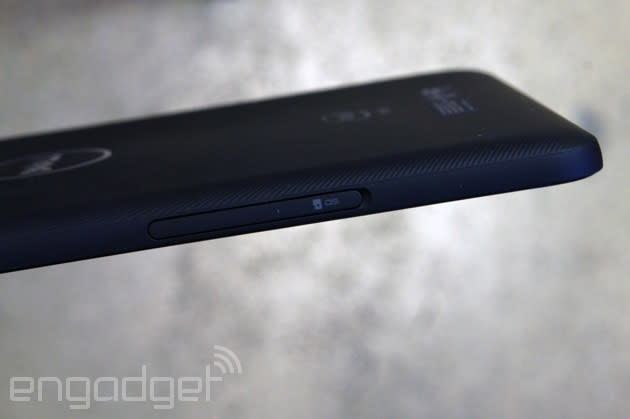
Remember when the Acer Iconia W3 came out and we gave a pass to most of its shortcomings because it was so reasonably priced? (And was the only 8-inch Windows 8 tablet.) How quaint, right? Today, the Dell Venue 8 Pro is one of several 8-inch Win 8 tablets, and for the record, they're all affordable. Starting with Acer (since we already name-checked it), the company has replaced the Iconia W3 with the W4, which brings a higher-quality panel with better viewing angles (the 1,280 x 800 resolution is the same, though). In addition, it's thinner and lighter than before, and makes use of a new Bay Trail processor -- as do all the tablets we're about to mention here. That retails for $330 and up, with the keyboard accessory sold separately. Only problem? It doesn't seem to be shipping yet. Womp womp.
Next up: the Toshiba Encore, the company's first 8-inch Windows tablet. If we go by specs and price alone, it's near-identical to the W4: 1,280 x 800 display, quad-core Bay Trail processor, a 2-megapixel front-facing camera and a price of $330 (available now). The only obvious difference? The rear camera shoots at 8 megapixels, not 5. Otherwise, we can't vouch for performance or battery life right now, since we haven't reviewed it yet. But do keep it in mind as you're shopping; it's clearly in the same class as all these other devices.
Ditto for the Miix 2 from Lenovo. This, too, has an 8-inch 1,280 x 800 display, a quad-core Intel Atom processor and dual 5MP/2MP cameras. Unlike the others, though, it's priced at an especially low $299. We haven't reviewed it yet, though, so we can't compare the performance right now.
Wrap-up

More Info
Should you buy the Venue 8 Pro? The answer isn't exactly "yes," and it isn't exactly "no." It's "wait." Wait for Dell to issue some firmware updates to address the aggressive auto-brightness settings and the flaky pen performance. And wait for more of these 8-inch Windows tablets to start shipping. It's easy to say that the Venue 8 Pro offers decent value for the money: You get a vibrant, 400-nit tablet display, long battery life and a processor powerful enough to run lightweight desktop apps when you need them.
Then again, we expect most of its rivals do too, given that they also make use of Intel's low-power Bay Trail chips. For the time being, it appears Dell might have won in the display department, thanks to that high brightness rating and also its ability to accept pen input (imperfect pen performance is better than none, we say, especially given that a fix is coming, and that very few budget tablets even offer this feature). On the other hand, the omission of a micro-HDMI port is odd, as is Dell's refusal to add a capacitive Start button. All things considered, we suspect the Venue 8 Pro can still hold its own against other 8-inch Windows tablets, but don't quote us on that until we test more of them. For now, though, it's clear the Venue 8 Pro offers a good deal of value for $300, and that its benefits ultimately outweigh its quirks.
Sean Buckley contributed to this review.



























